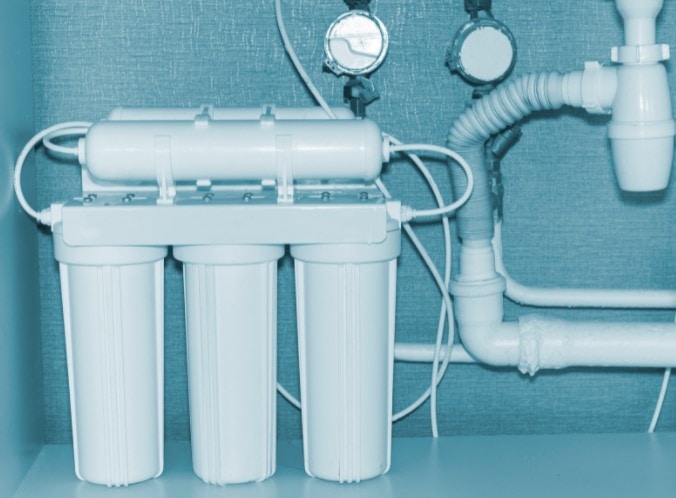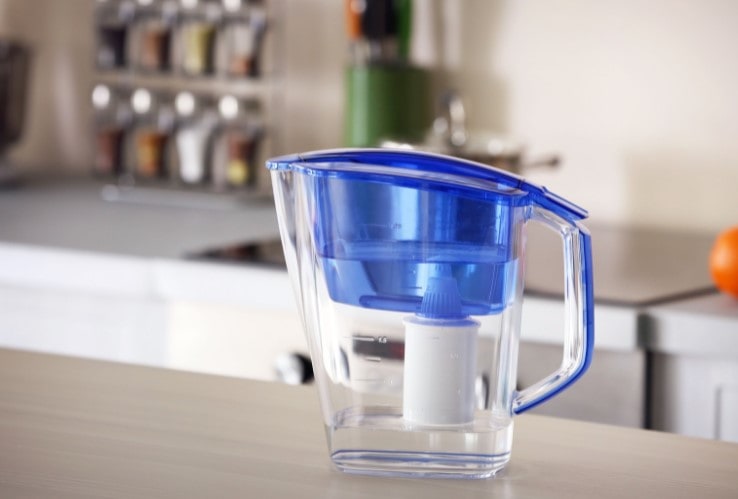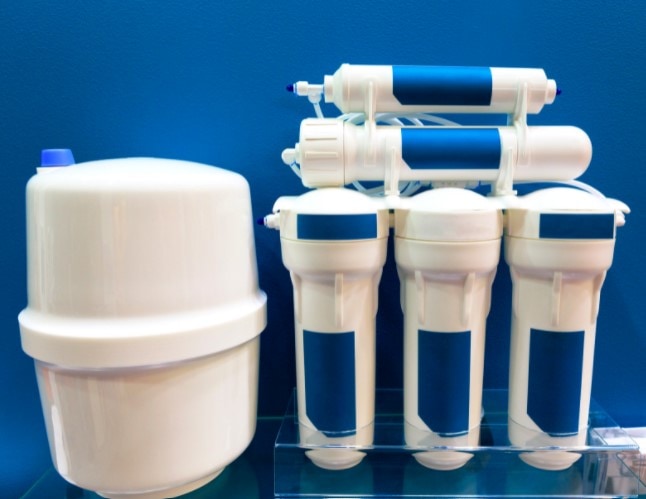Investing in a water filter for your home is the fastest and most complete way to get better tasting — and healthier — water. By stripping out the contaminants that give off flavors to your tap water, a water filter will encourage you to stay hydrated while eliminating the unnecessary elements that are so present in city or well water.
But choosing the right water filter for you is not as simple as you might think. That’s why we’ve put together this complete water filter buying guide: To give you a starting point for considering how each of the different types of water filters might fit into your home.
Together, we’ll cover every major topic you’ll need to understand to get great-tasting, healthy water — from water quality to common contaminants, to types of water filter systems and the brands we most recommend. By the time you’re finished reading, you’ll have a clear picture of exactly what’s best for you and your home.
Test Your Water: A Great Starting Point

No two water sources are completely identical — and if you’re treating your water source improperly, you won’t see the benefits that water filters have to offer.
In fact, the United States Environmental Protection Agency recommends that anyone considering a home water filtration unit should get their water tested. Because each type of filter system does a better or worse job at filtering out certain contaminants, you’ll need to identify which ones are present in your water before you can find the perfect filtering match.
So how do you get your water tested? If you’re on a city water supply, then you’re in luck. Through an annual Consumer Confidence Report, all municipal water suppliers are required to provide data on the quality of water they provide. If you own your home, contact your local water supplier for this report. And if you rent, contact your landlord so they can share the report with you.
There’s also the option for in-home testing using certified testing kits. The EPA has a directory for testing laboratories in every state. And you should definitely use this instead of a commercial testing kit that you can buy from Amazon. The results will be clear, and guaranteed accurate according to government standards.
That goes double for well water, which can be a rich source of contaminants depending on the area you live in. Always have well water tested yearly for changes, and use an EPA-certified laboratory test to do so.
Common Water Contaminants

After you get your water tested, you’ll need to understand what’s presented to you in the report. This is easily accomplished by understanding the common water contaminants regulated by the EPA.
It’s beyond the scope of this article to give a full detail of the health risks associated with each water contaminant.
- Nitrates
- Arsenic
- Fluoride
- Aluminum
- Bacteria (Waterborne Illness)
- Chloramine
- Chloride
- Lead
- Calcium
- Lime
What Do You Need From A Water Filter?
By now, you may be getting a clearer picture of how important water quality is to your health. So what do you need from a water filter for your water source? I think of water filters in three broad categories:
- Effectiveness
- Cost
- Size

In short: You want a water filter that works to make your water healthier and better-tasting. And you want it at a price that makes sense for your home budget. Keep reading, and we’ll cover each of these aspects in deeper detail.
How Much Can A Water Filter Actually Change Your Water Quality?
One of the biggest worries I hear from prospective water filter buyers is this:
What if my water doesn’t really taste any different?
If you haven’t noticed that your water quality is bad, it can be difficult to justify the cost of a water filter system.
But this is a trap! Because once you’ve been drinking water that is high in contaminants for a period of time, you’ll naturally stop noticing that it tastes bad. Compare your tap water side by side with filtered water, though, and you’ll likely notice a huge difference.
Applied properly, water filtration systems can drastically change the quality of your water. And by choosing only filters that are approved by the American National Standards Institute (ANSI) and NSF International, you can rest assured that you’re buying a quality product.
Types of Water Filter System

Water filters come in two broad categories:
- Point of entry systems that treat your whole house’s water supply
- Point of use systems that treat a specific water source (like your kitchen sink)
Let’s take a much closer look at both types of water filters.
Point of Entry Water Filters
Every house has a main water line that provides it with municipal or well water. Because of this, point of entry water filters can be fitted to this main line — and provide your entire house with fresh and filtered water.
Compared to point of use filters, point of entry filters are a much more complex choice. They’re more expensive, and they require professional installation to get good results.
But when they’re installed properly, whole house water filters can become a better deal over time. That’s because their filters are equipped to handle much larger volumes of water, and need to be replaced much less frequently than point of use filters. So while the upfront cost is higher, the price over 5 to 10 years is lower.
A note about flow rate: When you’re considering a whole house water filter, it’s vital that you look at the flow rate of the filter. Measured in gallons per minute (GPM), this is one of the most common complaints that comes along with point of entry filters.
Any whole house filter will reduce your flow rate to some degree, leading to lower water pressure that can be irritating when you’re taking a shower or doing the dishes. Look for filters that can handle at least 5 GPM, or up to 10 GPM or more if you have a larger household.
Point of Use Water Filters
Filters that work at a single point — like your shower head or kitchen sink — are undoubtedly the most popular water filters. They’re often inexpensive, and can be adjusted to fit your exact needs without breaking your budget.
For most households, a point of use filter will be their introduction to water filters. And if you’re primarily looking to improve the quality and taste of your drinking water, they’re a great way to get started. Let’s examine each type in more detail:
Under Counter

As their name implies, under counter water filters are installed directly beneath your sink. This has the benefit of freeing up counter space, while still providing fully filtered water from your tap. On the downside, if you have a small space under your sink it can be hard to find one that fits.
Under counter water filters are available in a wide range of filtration options. Simple single-stage systems are low maintenance, while multi-stage systems have the capacity to filter out more contaminants.
Countertop

If you have more space above your sink than below it, a countertop water filter is a good option. They screw directly onto your faucet, allowing you to filter large amounts of water with minimal installation hassles.
Countertop filters are excellent for drinking water, but often have a very limited flow rate. They’re also a rather affordable option in comparison to larger systems, but sometimes have a limited ability to filter contaminants.
Faucet

Similar to a countertop filter, a faucet-mounted filter attaches directly to your sink’s faucet. They’re often quite affordable and take up very little space, but have a limited filtering capacity. They also require more frequent filter changes than any of the filters we’ve already discussed. If you’re working in a small kitchen, though, a faucet-mounted filter may be the only option that will fit.
Pitcher

Pitcher filters are many people’s introduction to filtered drinking water. They’re exceedingly simple to use, and require little more than having space in your fridge. Of course, they’re not going to offer quite as robust of filtration as a whole-house or under-sink system. But if you’re looking for an inexpensive way to start drinking filtered water, a pitcher filter offers a quick solution.
Gravity

The pitcher filters discussed above are just one example of a broader category known as gravity filters. These are any type of water filter that achieves its filtration using only the force of gravity. Water is poured into a top chamber, then slowly filters into a bottom holding chamber that it can be dispensed from.
Methods of Filtration
Each of the types of water filters we covered in the above section is designed with a specific purpose in mind. Because of that, they each rely on different methods of filtration to achieve their purposes. By understanding these methods, you’ll get a clearer picture of the why and how behind each water filter’s design.
Adsorption

Adsorption is the most commonly applied method of water filtration. Activated carbon filters use this to great effect, with their highly porous surfaces effectively neutralizing unwanted tastes and odors. These types of filters are easy to install and maintain, but they also require the most frequent filter changes.
Reverse Osmosis

Reverse osmosis filters use pressure to push water through a semipermeable membrane. This means that while water can be let through the membrane, any larger molecules are trapped in the filter. These filters offer more complete removal of contaminants, and require fairly frequent maintenance just like carbon filters.
Distillation

By heating water to its boiling point, distillation filter systems collect the resulting steam and then pass it through a carbon filter. This has the dual benefit of heating the water to destroy contaminants, and then further purifying it with a filter. Systems with this type of filter are large though, and require a heating source to operate.
Ion Exchange

Ion exchange is the most controversial type of water filtration, owing to the accumulation of salt that the method entails. They’re relatively inefficient, requiring large amounts of water and salt that leads some to eschew them based on environmental concerns. They do, however, produce a very soft and smooth-tasting water.
Water Conditioning

Water conditioners offer a more environmentally responsible alternative to ion exchange systems. They use a process called template-assisted crystallization to remove unwanted contaminants without the need for large amounts of salt.
How To Target Specific Contaminants
Now you’re able to combine your knowledge of your water quality with the types of filters and methods of filtration available. This is a big step to take, as it means you can target the specific contaminants that are most present in your water.
The absolute best way to target specific contaminants in your water is to use the NSF’s database. By matching up the contaminants you want to remove with a filter that’s NSF-certified to do so, you can directly target what is making your water less pure.
Long-Term Costs of Water Filters
No matter what sort of filter system you choose, it will require long-term care and maintenance. No filter will work indefinitely, meaning that even the longest-lasting ones will still require filter changes at some point.
In addition to that, you should plan for the cost of installation necessary for each type of system. Whole house systems require professional installation. This can cost anywhere from $500 to $2500 or more, depending on the plumbing that needs to be added to your home. Point of use systems, on the other hand, can often be installed for free by homeowners.
This leads us to an important distinction: The easier a system is to install, the more frequently you’ll need to change the filters. A pitcher filter may need to be replaced as often as every month, while an under-sink system can last for 6 months or more. Whole house systems can be even longer-lasting, with filters that work for over a year.
Filter Certifications: Do You Need Them?
The EPA is in charge of ensuring that municipal water is up to governmental standards. But those standards don’t always include making sure that your water tastes good, or is completely free of contaminants. They only mean that the water is generally safe to drink.
Other certifying bodies take this a step further, and have much stricter guidelines for how effective a water filter should be. The Water Quality Association and National Safety Foundation certifications are the gold standard for water filters — guaranteeing that your water filter will do exactly what you expect of it.
The alternative — buying a water filter that is not certified by any governing body — can be a risky proposition. That’s because when you buy an NSF-certified water filter, you can directly match your water’s contaminants to the type of filter that will remove them. If you buy just any old water filter, there’s no real way to be certain that it will work.
The Best Water Filter Brands
The best water filter brands offer an excellent combination of three things:
- Certifications for effectiveness in filtration
- Thoughtful designs
- Affordability
Each of the filter brands featured below excels in a specific type of water filter — meaning that no one brand is the best at everything. Think of this as an introduction to the brands, rather than a full exploration of everything they have to offer.
Brita
One of the most visible water filter brands, Brita is responsible for popularizing the in-fridge pitcher. Their proprietary Longlast+ filters do an excellent job of making clean-tasting drinking water, but can tend to be expensive to replace. Other more affordable filters are also available though, making Brita a favorite of people with a wide range of budgets.
Pur
Offering faucet systems, pitchers, and dispensers, Pur has become a direct competitor to Brita. Their filters have a very clean aesthetic that looks great in a modern kitchen. To get a better idea of how their products work, check out their contaminant comparison chart for both pitcher and faucet filters.
Aquasana
Aquasana is the industry leader in whole house and under-sink systems. They also offer countertop and shower filter systems. While their products require a greater upfront investment, their filters are exceptionally long-lasting. Their Rhino filter system, for example, is rated for 1 million gallons before you’ll need to replace a filter.
A.O. Smith
Offering softeners, filtration systems, and water conditioners, A.O. Smith has a wide range of options for homeowners. The brand is exclusively sold at Lowes, and the design is identical to Aquasana’s. So while not as widely available as Aquasana, it’s a good alternative for under-sink and whole home systems.
Alexapure
If you’re interested in a gravity filtration system, Alexapure will probably be your first stop. Their low-tech systems are great for off-the-grid use, and require no electricity or running water to operate.
Berkey
An alternative to Alexapure, Berkey also makes low-tech, gravity-fed filter systems. They offer a much wider range of sizes though, allowing you to customize the fit to your needs.
Aquatru
Using patented technology, Aquatru offers a unique filter system. Their countertop water filter systems use reverse osmosis for purification, which very few other brands can claim. While more expensive than many other countertop filter systems, the quality of the water produced is excellent.
ZeroWater
ZeroWater’s five-stage ion exchange pitchers offer a higher degree of filtering than many other pitchers. This removes virtually all the dissolved solids from water, producing an exceptionally pure taste.
Summary: How To Select A Water Filter
So how can you decide which filter is right for you? It’s all about narrowing down your options. Here are the questions I ask myself to choose the best water filter for each situation:
- How much room do you have for your water filter? Whole house and under sink systems take up a lot of space, while pitcher, faucet, and countertop systems are real space savers.
- Do you want to make a larger initial investment? Or save more money long term? The less expensive a system is to buy upfront, the more often you’ll have to replace the filters.
- How important is complete filtration to you? Larger systems often have more robust filtration systems, while pitchers and the like have simpler filters.
When you’re clear on each of those questions, it’s just a matter of matching up the right brand’s products to your needs.
Frequently Asked Questions About Water Filters
And to round things out, let’s take a look at the most commonly asked questions about water filters:
Which water filter is best for me?
The best water filter for each person is the one that fits their budget, space requirements, and purity concerns. The above sections have more detail on how to consider each of these categories.
Which water filter is the best for drinking?
Any water filter system will create cleaner, healthier water. Pitcher, faucet, and countertop systems are the easiest to use, while under sink and whole house systems will create even purer water. The best water filter for drinking, then, is the one that matches your budget and space requirements.

